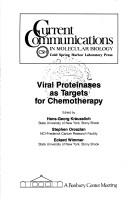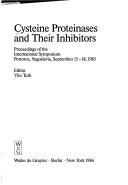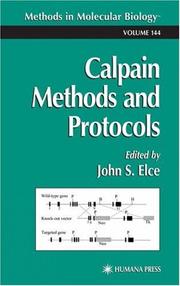| Listing 1 - 10 of 52 | << page >> |
Sort by
|
Book
ISBN: 0306448300 1461357616 1461518717 Year: 1995 Volume: 362 Publisher: New York, NY : Plenum Press,
Abstract | Keywords | Export | Availability | Bookmark
 Loading...
Loading...Choose an application
- Reference Manager
- EndNote
- RefWorks (Direct export to RefWorks)
Aspartic proteinases --- Congresses --- ASPARTIC PROTEINASES --- PHYSIOLOGY
Book
ISBN: 3110846837 Year: 2019 Publisher: Berlin ; Boston : De Gruyter,
Abstract | Keywords | Export | Availability | Bookmark
 Loading...
Loading...Choose an application
- Reference Manager
- EndNote
- RefWorks (Direct export to RefWorks)
Book
ISBN: 0306440520 1468460145 1468460129 Year: 1991 Volume: vol 306 Publisher: New York Plenum Press
Abstract | Keywords | Export | Availability | Bookmark
 Loading...
Loading...Choose an application
- Reference Manager
- EndNote
- RefWorks (Direct export to RefWorks)
Aspartic proteinases --- Aspartic Proteinases --- Congresses. --- genetics --- congresses. --- physiology --- Congresses --- Aspartic proteinases - Congresses. --- Genetics --- Physiology
Book
ISBN: 1281121029 9786611121020 9812707549 9789812707543 Year: 2007 Publisher: Hackensack, NJ World Scientific Pub.
Abstract | Keywords | Export | Availability | Bookmark
 Loading...
Loading...Choose an application
- Reference Manager
- EndNote
- RefWorks (Direct export to RefWorks)
Serpins constitute a superfamily of proteins that possess a unique tertiary structure and mechanism of proteinase inhibition. In humans, serpins constitute 10% of the plasma proteins and are best known as critical regulators of both the thrombotic and fibrinolytic systems. Serpins also participate in the regulation of the complement cascade, angiogenesis, tumor metastasis, apoptosis and innate immunity. Considering the importance of these molecules in regulating proteolytic cascades, it is not surprising to find that loss- and gain-of-function mutations result in significant human diseases. Ma
Serpins. --- Serpins --- Serine proteinases --- Physiological effect. --- Inhibitors
Book
ISBN: 9173936421 Year: 2009 Publisher: Linköping : Linkopings Universitet,
Abstract | Keywords | Export | Availability | Bookmark
 Loading...
Loading...Choose an application
- Reference Manager
- EndNote
- RefWorks (Direct export to RefWorks)
The book details the synthesis of molecules designed to inhibit the hepatitis C virus (HCV) NS3 serine protease and the human aspartic protease BACE-1. It explores the relationships between potential inhibitors and the targeted enzymes while discussing the class of enzymes known as proteases. The book also discusses why such enzymes can be regarded as suitable targets for developing drugs to combat diseases. It presents the results of the design and synthesis of linear and macrocyclic NS3 protease inhibitors containing a novel trisubstituted cyclopentane moiety as an N-acyl-(4 bioisostere. The book is intended for researchers and students in the field of medicinal chemistry and drug design.
Aspartic Proteinases. --- Hepatitis C Virus. --- Enzyme Inhibitors.
Book
ISBN: 1620815478 9781612093437 1612093434 9781620815472 9781620815472 Year: 2011 Publisher: New York
Abstract | Keywords | Export | Availability | Bookmark
 Loading...
Loading...Choose an application
- Reference Manager
- EndNote
- RefWorks (Direct export to RefWorks)
Cystatins. --- Cysteine proteinases --- Cystatin superfamily --- Proteins --- Inhibitors. --- Inhibitors

ISBN: 0879693355 Year: 1989 Publisher: Cold Spring Harbor (N.Y.) : Cold Spring Harbor laboratory,
Abstract | Keywords | Export | Availability | Bookmark
 Loading...
Loading...Choose an application
- Reference Manager
- EndNote
- RefWorks (Direct export to RefWorks)
Antiviral agents --- Viral proteinases --- Testing --- Congresses. --- Inhibitors --- Congresses.
Book
ISBN: 1612093507 Year: 2010 Publisher: New York : Nova Science Publishers,
Abstract | Keywords | Export | Availability | Bookmark
 Loading...
Loading...Choose an application
- Reference Manager
- EndNote
- RefWorks (Direct export to RefWorks)
Serine proteinases --- Serpins --- Protein Kinases --- Inhibitors. --- Physiological effect.

ISBN: 089925263X 3110107244 Year: 1986 Publisher: Berlin De Gruyter
Abstract | Keywords | Export | Availability | Bookmark
 Loading...
Loading...Choose an application
- Reference Manager
- EndNote
- RefWorks (Direct export to RefWorks)
Cysteine proteinases --- Cysteine --- Endopeptidases --- Protease Inhibitors --- Congresses --- Inhibitors --- antagonists & inhibitors

ISBN: 0896036324 9786610820429 128082042X 1592590500 Year: 2000 Publisher: Totowa, NJ : Humana Press : Imprint: Humana,
Abstract | Keywords | Export | Availability | Bookmark
 Loading...
Loading...Choose an application
- Reference Manager
- EndNote
- RefWorks (Direct export to RefWorks)
In Calpain Methods and Protocols, John S. Elce and a seasoned team of principal investigators present a set of proven and easily followed protocols for studying calpain. The methods include in vitro techniques for the detection, expression, purification, and assay of µ- and m-calpain, supplemented with a wide range of system and tissue models for studying both the physiological functions and the effects of inhibitors on calpain. The systems used include neural tissue, kidney, liver, the eye, and membrane fusion in muscle and erythrocytes, each in connection with hypoxia or other injury. Among the analytical techniques employed are casein zymography, immunofluorescence, and calpain activity assays. The authors also examine specific substrates that have been proposed for the calpains. Highly practical and readily repeatable, Calpain Methods and Protocols offers investigators involved in basic and clinically oriented calpain research a gold-standard collection of powerful experimental tools for discovering the nature and function of calpains.
Calpain --- Cysteine proteinases. --- Proteinase --- Calcium-dependent cysteine proteinase --- Cysteine proteinases --- Neurosciences. --- Neural sciences --- Neurological sciences --- Neuroscience --- Medical sciences --- Nervous system
| Listing 1 - 10 of 52 | << page >> |
Sort by
|

 Search
Search Feedback
Feedback About UniCat
About UniCat  Help
Help News
News